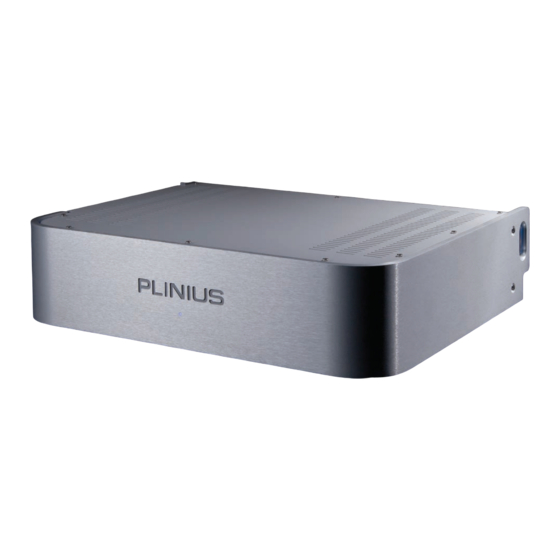Table of Contents
Advertisement
Quick Links
Download this manual
See also:
Instruction Manual
Advertisement
Table of Contents

Summary of Contents for Plinius P10
- Page 1 Power Amplifier Instruction Manual The heart of music www.pliniusaudio.com...
-
Page 3: Table Of Contents
All operational, technical and descriptive material in this publication is subject to change at any time without notice. For further product information or queries, please contact your Plinius dealer. Plinius products are designed and manufactured by Plinius Audio Limited, New Zealand. -
Page 4: Introduction
We have designed and manufactured this amplifier to reproduce your favourite music faithfully and accurately. With a little care and a full understanding of the operating recommendations in this manual, your Plinius P10 Power Amplifier will provide years of high-quality, trouble-free performance. -
Page 5: Design Philosophy
Design Philosophy From a distance you can see that the design of the Plinius products is more than an applied styling exercise to the front panel. We have started from the ground up to produce a casing for our electronics that is unrivalled in its physical strength and visual simplicity. -
Page 6: Unpacking
Unpacking Open the box from the top and remove the accessories from the foam end caps. You may now proceed to lift the unit from the box, Once the unit is removed you can proceed with the removal of the foam end caps. These caps are designed to fit on the front and back of the unit for maximum protection. -
Page 7: Care & Maintenance
Care & Maintenance With simple care and maintenance your Plinius product can be kept looking and operating like new for many years to come. MAINTAINING THE CONNECTORS Exposed connectors such as the RCA connectors will be subject to environmental factors, and over time the surface may degrade. This can be greatly reduced by fitting readily available ‘RCA caps’... -
Page 8: Precautions
PLEASE TAKE SPECIAL NOTE OF THE FOLLOWING PRECAUTIONS BEFORE OPERATING YOUR NEW AMPLIFIER. • The Plinius P10 Power Amplifier can deliver in excess of 200 watts into 8 ohms. This amplifier is also capable of a very large peak current delivery. •... -
Page 9: Rear Panel Functions
Mains switch on and off repeatedly. 2. INPUT TERMINALS The input terminals for your Plinius P10 Power Amplifier are easily accessible at the centre of the rear panel. RCA INPUTS LEFT & RIGHT: These standard RCA terminals are for use with unbalanced signals from most signal sources such as audio preamplifiers. - Page 10 By connecting a processor with a remote trigger signal to these terminals, the P10 can be put in and out of standby by the processor to which it is connected. When in standby, the amplifier draws less current and will operate at minimum temperature.
-
Page 11: Installation & Operation
Balanced XLR interconnect cables only. If using single-ended RCA inputs, connect your preamplifi er to the RCA inputs on the back of the Plinius P10. Make sure you connect the red coded cable to the red RIGHT RCA input, and the black (or white) cable to the white LEFT RCA input. - Page 12 Bi-wiring uses two pairs of loudspeaker cables for each channel loudspeaker. You will notice that the rear panel of your Plinius P10 has two pairs of output terminals for this purpose. Be sure to follow correct practises for stereo and mono configurations when using bi-wiring.
- Page 13 Check the P10 is switched OFF, and connect the IEC end of the cable to the IEC socket at the back of the P10. With the cord fully connected, switch the wall outlet ON.
-
Page 14: Product Features
Plinius dealer. OVER TEMPERATURE PROTECTION The P10 Power Amplifier is fitted with an auto-reset thermal sensor. The sensor is located at the main power transformer and should the transformer internal temperature exceed 110°C (230°F) the power will be disconnected from the unit. The unit will remain off until the temperate has reduced significantly, and then the sensor will automatically reset to the ON state. -
Page 15: Loudspeaker Selection
Loudspeaker Selection Your Plinius P10 Power Amplifier is designed for use with high fidelity loudspeakers. It should not be used to operate any other type of appliance or equipment. Choice of loudspeakers is one of personal taste, providing the chosen loudspeakers are suitable for use with your amplifier. -
Page 16: Troubleshooting
Troubleshooting NO SOUND FROM THE UNIT If the unit is not reproducing audio take the following steps: • Check the Preamplifier is correctly connected to an appropriate input on the Unit. • Check the source is playing, and not paused or muted. If it has adjustable volume, check this is at the usual output level. -
Page 17: Specifications
Specifications POWER 200 watts RMS per channel into 8 ohms. Both channels driven from 20Hz to 20kHz at less than 0.2% total harmonic distortion. FREQUENCY RESPONSE 20Hz to 20kHz +/–2dB –3dB at 5Hz and –3dB at 70kHz DISTORTION Typically <0.05% THD at rated power 0.2% THD and IM worst case prior to clipping CURRENT OUTPUT 40A short duration peak per channel... -
Page 18: Index
Index Bi-wiring ......................10 Care & Maintenance................5 Display LED....................6 Front Panel Layout ................6 Fuse Protection ..................8, 12 Ground Lift Switch ................8 IEC Power Connector ................8, 11 Input Terminals ..................7, 9 Loudspeaker Impedance ..............13 Loudspeaker Power ................13 Mains/Line Fuse ..................12 Mains Supply Connection .............11 Mains Switch .....................7 Operating Temperature..............4 Output Terminals ...................8, 10...














Need help?
Do you have a question about the P10 and is the answer not in the manual?
Questions and answers